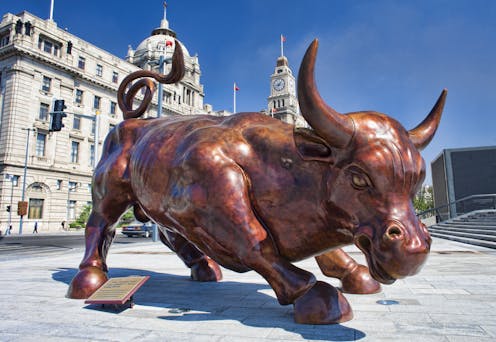Chinese economic growth may never recover from COVID – here's why
- Written by Kent Matthews, Professor of Banking and Finance, Cardiff University

Many countries[1] have had to navigate[2] the balancing act of keeping the economy alive versus protecting citizens from COVID in recent years. In China, patience with its zero-COVID policy[3] – one of the world’s toughest strategies for dealing with the pandemic – are wearing thin among workers and students. Sporadic protests have erupted all over China in recent weeks, triggered by the deaths[4] of ten people in a fire in an apartment block in Ürümchi, Xinjiang in November[5].
But even with signs that restrictions are starting to relax[6] across the country, the impact on the economy will not be as straightforward as the Chinese government might hope.
The conundrum for China is that the state has promised its citizens safety from the virus through its zero-COVID policy, which has led to large sections of the vulnerable population[7] being unvaccinated. No government wants to concede it may have been wrong about something, but it’s particularly important for the credibility of the social contract[8] between the Chinese Communist Party and the people. The authorities guarantee social and economic stability and the freedom to get rich, in exchange for absolute power.
But with the slowing of China’s GDP growth, rising graduate unemployment (youth unemployment reached 20% in July[9]), and increasing economic hardship, China’s social contract is starting to unravel[10].
Chinese government decision making
The upside of authoritarian governance is that decisions can be made quickly in times of crisis. The Chinese government was quick to react to the 2008 global financial crisis with a 4 trillion yuan (£470 billion) fiscal package[11]. After a sharp fall in GDP in 2008, the economy grew by 8.7% in 2009 and over 10% in 2010. The rate of growth[12] then settled at a healthy but sustainable 6.8%.
When dealing with the pandemic, after the initial confusion about its source and apportionment of blame, the government acted swiftly to lock down the economy and flatten the curve. The result was that only 5,233 COVID deaths had been reported[13] as of December 2022, compared to 1.1 million in the US.
But daily COVID cases in China were at 37,828 on November 30 2022[14]. This is higher than the peak in April when the economically damaging lockdown in Shanghai[15] was imposed. And GDP fell by 2.6% in the second quarter of this year before recovering with a 3.6% rise in the next quarter.
So clearly there is a trade-off to consider between the economic and social cost of China’s zero-COVID policy and the health benefits for the vulnerable. This means it’s important to consider the short-term cost of the lockdown, as well as any long-term consequences.
The immediate costs have been the disruption to production and global supply chains, but the domestic service sector was also particularly hard hit. The chart below shows how economic growth has moved from a steady quarterly rate of 1.7% following the 2008 global financial crisis, to a collapse and recovery in 2020 and a second downturn in quarter two of 2022.
Growth in China from the global financial crisis to COVID
References
- ^ countries (commonslibrary.parliament.uk)
- ^ navigate (www.brookings.edu)
- ^ zero-COVID policy (www.bbc.co.uk)
- ^ triggered by the deaths (theconversation.com)
- ^ in November (apnews.com)
- ^ restrictions are starting to relax (www.theguardian.com)
- ^ large sections of the vulnerable population (www.theguardian.com)
- ^ the social contract (web.archive.org)
- ^ youth unemployment reached 20% in July (www.statista.com)
- ^ starting to unravel (www.nbcnews.com)
- ^ 4 trillion yuan (£470 billion) fiscal package (www.oecd-ilibrary.org)
- ^ rate of growth (data.worldbank.org)
- ^ only 5,233 COVID deaths had been reported (ourworldindata.org)
- ^ 37,828 on November 30 2022 (www.google.com)
- ^ economically damaging lockdown in Shanghai (www.reuters.com)
- ^ Author provided, data from National Bureau of Statistics of China. (fred.stlouisfed.org)
- ^ Federal Reserve Economic Data (FRED) (fred.stlouisfed.org)
- ^ population figures from the World Bank (data.worldbank.org)
- ^ research shows (www.imf.org)
- ^ output loss (www.imf.org)
- ^ rarely recovered (www.aeaweb.org)
- ^ rethinking their supply chain arrangements (techwireasia.com)
- ^ heading for the exit (www.intereconomics.eu)
- ^ debt to GDP rose to 270% in 2020 (www.dailyfx.com)
- ^ set to rise to 78% in 2022 (www.statista.com)
- ^ recent research (www.journals.uchicago.edu)
Read more https://theconversation.com/chinese-economic-growth-may-never-recover-from-covid-heres-why-195872







